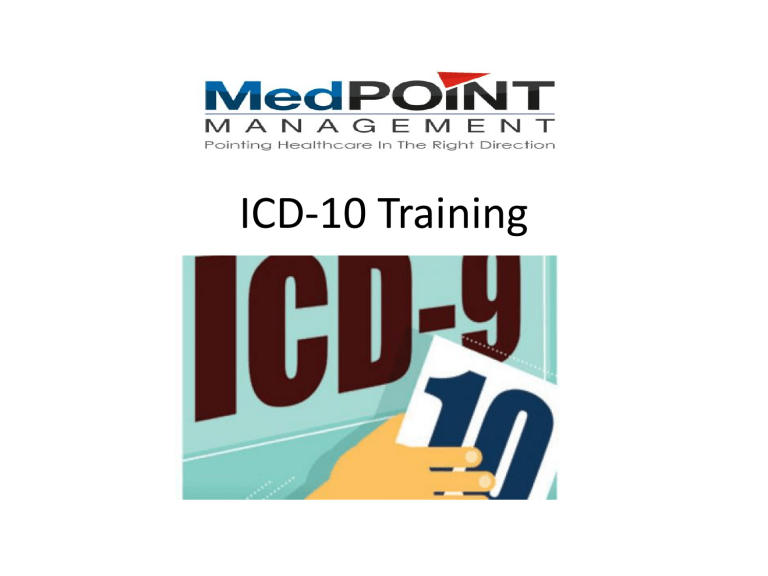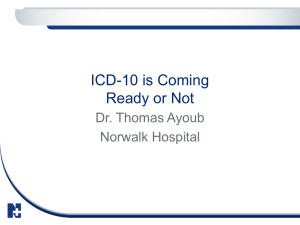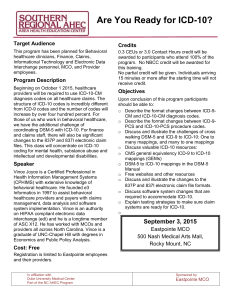ICD-10-Presentation1

ICD-10 Training
\ Why we need to understand ICD-10
If we receive non-compliant codes (problem in the provider space) OR incorrectly associate ICD-10 diagnosis codes in our systems (problem in the payer space)…. then there is major disruption…and if there’s disruption…
Provider has to call the payer→ Payer has to answers questions, requests other information →
Claims are delayed →Disruption in cash flows →No one is happy
It is in everyone’s best interest to work toward a seamless transition
ICD-9 VERSUS ICD-10
ICD-9
• 3-5 Numbers in length
• Alpha E and V on 1st character
• 13,000 codes
• Based on outdated technology
• Limited space for adding new codes
• Generic terms for body parts
• Lacks detail
• Lacks laterality
• Difficult to analyze data due to non-specific codes
• Combination codes limited
• Not used by other countries
ICD-10
• 3-7 Alphanumeric characters in length
• Alpha or numeric for any character
• 87,000 codes
• Reflects current usage of medical terminology and devices
• Flexibility to add new codes
• Detailed descriptions for body parts
• Very specific
• Laterality
• Specificity improves coding accuracy and depth of data for analysts
• Combination codes common
CODING CHAPTERS
ICD-9-CM ICD-10-CM ICD Chapters
1 Certain Infectious and Parasitic Diseases
2 Neoplasms
Diseases of the Blood and Blood-Forming Organs and Certain
Disorders Involving the Immune Mechanism
3
Endocrine, Nutritional, and Metabolic Diseases
4
5 Mental and Behavioral Disorders
6 Diseases of the Nervous System
7 Diseases of the Eye and Adnexa
8 Diseases of the Ear and Mastoid Process
001–139
140–239
280–289 (only includes diseases of blood and bloodforming organs)
240-279 (also includes immunity disorders)
290–319
320–389 (Diseases of the
Nervous System and Sense
Organs)
A00–B99
C00–D49
D50–D89
E00–E89
F01–F99
G00–G99
H00–H59
H60–H95
9 Diseases of the Circulatory System
10 Diseases of the Respiratory System
11 Diseases of the Digestive System
12 Diseases of the Skin and Subcutaneous Tissue
Diseases of the Musculoskeletal System and Connective Tissue
390–459
460–519
520–579
680–709
710–739
I00–I99
J00–J99
K00–K94
L00–L99
M00–M99
13
14
15
Diseases of the Genitourinary System
Pregnancy, Childbirth, and the Puerperium
Certain Conditions Originating in the Perinatal Period
580–629 N00–N99
630–677 (Complications of
Pregnancy, Childbirth, and the
Puerperium)
O00–O9a
760–779 P00–P96
16
17
Congenital Malformations, Deformations, and Chromosomal
Abnormalities
Symptoms, Signs, and Abnormal Clinical Laboratory Findings, Not
Elsewhere Classified
740–759 (Congenital
Anomalies)
780–799 (Symptoms, Signs, and Ill-Defined Conditions)
18
Injury Poisoning and Certain Other Consequences of External Causes 800–999 (Injury and
19
20 External Causes of Morbidity
Poisoning)
E800–E999
Supplementary Classification of External Causes of Injury and
Poisoning Factors Influencing Health Status and Contact with Health
Services
V01–V83 Supplementary
Classification of Factors
Influencing Health Status and
Q00–Q99
R00–R99
S00–T98
V00–Y98
Z00–Z99
MEDICAL CONDITIONS CHANGES WITH ICD-10
Clinical Area
Fractures
Poisoning and toxic effects
ICD-9 Codes
747
244
ICD-10 Codes
17099
4662
Pregnancy related conditions
Brain Injury
Diabetes
Migraine
Bleeding disorders
Mood related disorders
1104
292
69
40
26
78
2155
574
239
44
29
71
Hypertensive disease 33 14
End Stage Renal Disease 11 5
Chronic respiratory failure 7 4
ICD-9 VERSUS ICD-10
Coding Structure
Major Change with ICD-10
36 % of all ICD-10 codes distinguish right vs left
• 50 % of the codes are related to musculosketal
• 25% of the codes are related to fractures
62% of the fracture codes distinguish right versus left
Chapter 1-Infectious Disease
Codes starting with A-B
•Includes diseases generally recognized as communicable or transmissible.
•Sepsis (ICD-10-CM) has replaced Septicemia (ICD-9-CM)
•Urosepsis is a nonspecific term and is not coded in ICD-10-CM. Should a provider use this term, he/she must be queried for clarification
•“Late Effects” of Infectious and Parasitic Diseases (ICD-9-CM) is now
“Sequela” of infectious and Parasitic Diseases in ICD-10-CM
•Infections resistant to antibiotics requires the use of an additional code for any associated drug resistance only if the infection code does not identify drug resistance (Z16 category, resistance to antimicrobial drugs)
•Many of the codes are combined conditions and common symptoms
• HIV
042
Chapter 1-Infectious Disease
Example
ICD-9 CODE ICD-10 CODE
• HIV
B20
• HIV Positive
V08
• HIV Positive
Z21
Chapter 2-Neoplasms (Cancer)
Codes starting with C-D
Key updates to the Neoplasm chapter include:
•Classification improvements
•Code expansions - Significant expansion in the malignant neoplasm of male breast codes
•Revisions to identify laterality for some of the neoplasm sites
Chapter 2- Cancer Example
Malignant Neoplasm Breast
• 54 choices for male/female breast
• Documentation must include: Laterality
• Location
• Example: C50.422 Malignant neoplasm of upper-outer quadrant of the left male breast
Chapter 2-Cancer
Example
ICD-9 CODE
• Breast Cancer, Male
175.9
•
•
•
•
•
•
•
•
•
•
•
•
•
ICD-10 CODE
Breast Cancer, Male
C50.221 Malignant neoplasm of upper-inner quadrant of right male breast
C50.222 Malignant neoplasm of upper-inner quadrant of left male breast
C50.229 Malignant neoplasm of upper-inner quadrant of unspecified male breast
C50.321 Malignant neoplasm of lower-inner quadrant of right male breast
C50.322 Malignant neoplasm of lower-inner quadrant of left male breast
C50.329 Malignant neoplasm of lower-inner quadrant of unspecified male breast
C50.421 Malignant neoplasm of upper-outer quadrant of right male breast
C50.422 Malignant neoplasm of upper-outer quadrant of left male breast
C50.429 Malignant neoplasm of upper-outer quadrant of unspecified male breast
C50.521 Malignant neoplasm of lower-outer quadrant of right male breast
C50.522 Malignant neoplasm of lower-outer quadrant of left male breast
C50.529 Malignant neoplasm of lower-outer quadrant of unspecified male breast
Chapter 3-Blood Disorders
Codes starting with D
Anemia is the most common condition included in this chapter. The use of specific terminology is important in applying codes for this condition.
Updates include:
• Classification improvements
• Code expansions
• Updates to medical terminology
Chapter 3-Blood Disorder
Examples
ICD-9 CODES
• Anemia in Chronic Kidney
Disease
285.21
ICD-10 CODES
• Anemia in Chronic Kidney
Disease
D63.1
• Anemia
285.9
• Anemia
D64.9
Chapter 4-Endocrine,Nutrition
Codes starting with E
Code expansions and updates to medical terminology
The largest change noted is to the Diabetes Mellitus classification
• Diabetes mellitus codes are now combination codes that include the type of diabetes (1 or 2), the body system affected and complications affecting the body system (Retinopathy, Neuropathy, Arthropathy,
Peripheral angiopathy with gangrene, etc.)
• As many codes within a particular category as are necessary to describe all of the complications of the disease may be used.
Chapter 4 Example
Diabetic Complications
ICD-9
• 250.50 Diabetes with ophthalmic manifestations
• 362.07 Diabetic macular edema
• 362.05 Moderate nonproliferative diabetic retinopathy
ICD-10
• E11.331 Type 2 diabetes mellitus with moderate nonproliferative diabetic retinopathy with macular edema
A patient with diabetic chronic kidney disease, stage 3 and takes insulin on a daily basis.
ICD-9
• 250.40 Diabetic
Nephropathy
• 585.3 Chronic Kidney
Disease, Stage 3
• V58.67 Long term use of insulin
ICD-10
• E11.22 Type II Diabetes with diabetic kidney disease
• N18.3 Chronic Kidney
Disease, Stage 3
• Z79.4 Long term (current) use of insulin
Chapter 4 Continued
The classification for overweight and obesity has been expanded
It includes:
• Obesity due to excess calories
• Morbid (severe) obesity due to excess calories
• Other obesity due to excess calories
• Drug induced obesity
• Morbid (severe) obesity due to alveolar hypoventilation
• Overweight
• Other obesity
• Obesity unspecified
• An additional code (Z68-) is used to identify the body mass index
(BMI), if known.
Chapter 4 Endocrine continued
Example
• BMI= 40
V85.41
ICD-9
• BMI= 40
Z68.40
ICD-10
• 278.01
Morbid Obesity
• E66.01
Morbid Obesity
Chapter 5-Mental Health
Codes starting with F
Code expansions
• Most notably, Other Isolated or Specific Phobias
• Updates to medical terminology
• Bipolar I disorder, single manic episode will change to
Manic episode
• Undersocialized conduct disorders, aggressive will become
Conduct disorder childhood-onset type
• Nicotine dependence updated to identify specific tobacco products (cigarettes, chewing tobacco, other tobacco)
• Alcohol abuse and dependence codes no longer identify continuous or episodic use
Mental Health
Chapter 5 Example
ICD-9
• 314.00--Attention deficit disorder, without mention of hyperactivity
• 314.01--Attention deficit disorder, with hyperactivity
ICD-10
• F90.0 -- Attention-deficit hyperactivity disorder, predominantly inattentive type
• F90.1 -- Attention-deficit hyperactivity disorder, predominantly hyperactive type
• F90.2 -- Attention-deficit hyperactivity disorder, combined type
• F90.8 -- Attention-deficit hyperactivity disorder, other type
• F90.9 -- Attention-deficit hyperactivity disorder, unspecified type
Chapter 6-Nervous System
Codes starting with G
The sense organs (eye/adnexa and ear/mastoid processes) have their own chapters in ICD-10-CM.
• Classification improvements (significant changes to sleep disorders)
• Code expansions (e.g. Alzheimer’s, headaches)
• Updates to medical terminology (epilepsy, seizures)
Nervous System
Chapter 6 Example
ICD-9
• 338.4
Chronic Pain Syndrome
ICD-10
• G89.4
Chronic Pain Syndrome
• 345.90
Epilepsy, unspecified
• G40.901
Epilepsy, unspecified, not intractable, with status epilepticus
• G40.909
Epilepsy, unspecified, not intractable, without status epilepticus
Chapter 7-Diseases of Eye
Codes starting with H
Diseases of the Eye and Adnexa is a new chapter in ICD-10-CM.
• Terminology improvements (bringing terms up to date)
• ICD-10-CM contains codes for right side, left side and in some instances bilateral sides for diseases of the eye and adnexa.
• An unspecified site is also provided should the site not be identified in the medical record.
• If no bilateral code is provided and the condition is bilateral, assign separate codes for both the left and right side.
Chapter 7-Disease of the Eye
Example
ICD-9 CODE ICD-10 CODE
• 361.9 Retinal Detachment
• H33.001 Unspecified retinal detachment with retinal break, right eye
• H33.001 Unspecified retinal detachment with retinal break, left eye
• H33.003 Unspecified retinal detachment with retinal break, bilateral
• H33.009 Unspecified retinal detachment with retinal break, unspecified eye
Chapter 7-Disease of the Eye
Example
ICD-9 CODE
• 365.11
Primary open angle glaucoma
ICD-10 CODE
• H40.11X0
Primary open-angle glaucoma stage unspecified
• H40.11X1
Primary open-angle glaucoma stage mild
• H40.11X2
Primary open-angle glaucoma stage moderate
• H40.11X3
Primary open-angle glaucoma stage severe
• H40.11X4
Primary open-angle glaucoma stage indeterminate
Chapter 8-Diseases of the Ear
Codes starting with H
This is a new chapter in ICD-10
• Codes are grouped to make it easier to identify the types of conditions
• There is also a greater specificity and detail in the codes
• Many codes have laterality designation.
Chapter 8-Diseases of the Ear
Example
ICD-9 CODES
• 381.3
Chronic allergic otitis media
• 380.4
Ear Impaction
ICD-10 CODES
• H65.411 Chronic allergic otitis media, right ear
• H65.412 Chronic allergic otitis media, left ear
• H65.413 Chronic allergic otitis media, bilateral
• H65.419 Chronic allergic otitis media, unspecified ear
• H61.20 Unspecified ear
• H61.21 Right ear
• H61.22 Left ear
• H61.23 Bilateral
Chapter 9-Circulatory
Codes starting with I
Similar structure to ICD-9-CM, but there are classification changes to be aware of
Terminology used to describe several cardiovascular conditions has been revised to reflect more current medical practice
A major change is the classification of hypertension, which in
ICD-9-CM was classified by type: benign, malignant or unspecified. That classification is not required in ICD-10-CM.
The code for hypertension has been updated to one code for essential (primary) hypertension. That code is I10.
Chapter 9-Circulatory
Example
ICD-9 CODES
Hypertension
• 401.0 Malignant
• 401.1 Benign
• 401.9 Unspecified
ICD-10 CODES
Hypertension
• I10
Chapter 10- Respiratory
Codes starting with J
Modifications have been made to specific categories that bring the terminology up-to-date with current medical practice.
• Emphysema now contains codes with panlobular and centrilobular in their titles
• Asthma is now classified as mild intermittent, mild persistent, moderate persistent and severe persistent.
• Specificity increased for diseases like influenza, acute bronchitis
• Coding guidelines updates to require the coder to include information about tobacco use/dependence, where applicable.
Chapter 10
Respiratory Example
ICD-9 ICD-10
• 493.12
Intrinsic Asthma with acute exacerbation
• 496 COPD
• J45.51
Severe persistent asthma with acute exacerbation
• J44.9 COPD
Chapter 10
Respiratory Example
ICD-9
• 493.01
Extrinsic asthma with status asthmaticus
ICD-10
• J45.22 Mild intermittent asthma with acute status asthmaticus
• J45.32 Mild persistent asthma with acute status asthmaticus
• J45.42 Moderate persistent asthma with acute status asthmaticus
• J45.52 Severe persistent asthma with acute status asthmaticus
Chapter 11-Digestive
Codes starting with K
A number of new subchapters have been added to this chapter
(including liver diseases)
• Some terminology changes and revisions to the classification of specific digestive conditions:
The term hemorrhage is used when referring to ulcers
The term bleeding is used when classifying gastritis, duodenitis, diverticulosis and diverticulitis
• There is new specificity to conditions like Crohn’s disease, which have been expanded to specify site, if a complication is present, and what the complication is.
ICD-9
• 530.81
GERD
Reflux Disease
Chapter 11-Digestive
Example
ICD-10
• K21.0
Gastro-esophageal reflux disease with esophagitis
• K21.9
Gastro-esophageal reflux disease without esophagitis
Chapter 12-Skin
Codes starting with L
This chapter has been completely restructured to bring together groups of diseases that are related to one another in some way.
• Greater specificity has been added to many of the codes at the 4th, 5th or 6th character level.
• It has 9 subchapters (compared to 3 in ICD-9-CM)
• There are many changes to the ulcers sectionpressure ulcer codes are combination codes that identify site and stage of the ulcer.
• Procedural complications of the skin and subcutaneous tissue are included.
ICD 9
• 707.13
Ulcer of the ankle
Right side
Chapter 12-SkinCodes
Example
ICD 10
• L97.311
Non-pressure chronic ulcer of right ankle, limited to breakdown of skin
• L97.312
Non-pressure chronic ulcer of right ankle with fat layer exposed
• L97.313
Non-pressure chronic ulcer of right ankle with necrosis of muscle
• L97.314
Non-pressure chronic ulcer of right ankle with necrosis of bone
• L97.319
Non-pressure chronic ulcer of right ankle with unspecified severity
Chapter 13-Musclosketal
Codes starting with M
Most of the codes within this chapter have site and laterality designations.
• ICD-10-CM identifies three different causes for pathological fractures: neoplastic disease, osteoporosis, and other specified disease.
• ICD-10-CM introduces the 7th character that describes type of encounter or the state of the fracture’s healing and any sequela. Some of the codes in this chapter have a 7th character applied.
Chapter 13-Musclosketal
Codes
• 724.2
Back pain
ICD 9 ICD 10
• M54.5
Low back pain
• 719.41
Shoulder pain
• M25.511 Shoulder pain, right
• M25.512 Shoulder pain, left
• M25.519 Shoulder pain, unspecified
Chapter 14-Genitourinary
Codes starting with N
Procedural complications affecting the genitourinary system are included in this chapter.
• Laterality is used to identify conditions under
N60 category, benign mammary dysplasia.
• In some of the categories, specificity is based on the gender of the patient.
Chapter 14-Genitourinary
Example
ICD-9
• 585.6
End Stage Renal Disease
ICD-10
• N18.6
End Stage Renal Disease
• 600.00
Enlarge Prostate
• N40.0
Enlarge Prostate
Chapter 15-Obsterics/Gynecology
Codes starting with O
Trimester is now the axis of classification rather than the current episode of care, i.e. delivered, antepartum, postpartum
• The majority of codes in this chapter have a final character for trimester of pregnancy.
• Trimesters
1st Less than 14 weeks 0 days
2nd 14 weeks 0 days to less than 28 weeks 0 days
3rd 28 weeks 0 days until delivery
Chapter 15-Obsterics/Gynecology
Example
ICD-9
• 642.4
Unspecified pre-eclampsia
ICD-10
• O14.90 Unspecified preeclampsia, unspecified trimester
• O14.92 Unspecified preeclampsia, second trimester
• 014.93 Unspecified preeclampsia, third trimester
648.80
Gestational Diabetes
O99.810
Gestational Diabetes
Chapter 15-Obsterics/Gynecology
Example
ICD-9 CODE
• 642.00
Pre-Existing hypertension
ICD-10 CODE
• O10.011
Pre-Existing hypertension complicating pregnancy, first trimester
• O10.012
Pre-Existing hypertension complicating pregnancy, second trimester
• O10.013
Pre-Existing hypertension complicating pregnancy, third trimester
• O10.019
Pre-Existing hypertension complicating pregnancy, unspecified trimester
Chapter 15-Obsterics/Gynecology
Example
ICD-9 CODE
• V23.85
Supervision of pregnancy resulting from assisted reproductive technology, unspecified trimester
ICD-10 CODE
• O09.811
Supervision of pregnancy resulting from assisted reproductive technology, first trimester
• O09.812
Supervision of pregnancy resulting from assisted reproductive technology, second trimester
• O09.813
Supervision of pregnancy resulting from assisted reproductive technology, third trimester
• O09.819
Supervision of pregnancy resulting from assisted reproductive technology, unspecified trimester
Chapter 16-Perinatal
Codes starting with P
Codes from this chapter are for use on newborn records only, never on maternal records and include conditions that have their origin in the fetal or perinatal period (before birth through the first 28 days after birth) even if morbidity occurs later.
• Different codes are used for “light for gestational age” and “small for gestational age”.
• Codes for assigning birth trauma have been expanded to include more specificity.
Chapter 16-Perinatal
Example
ICD-9
• 760.79
Newborn affected by exposure in utero to tobacco smoke
ICD-10
• P04.2
Newborn affected by exposure in utero to tobacco smoke
• 760.71
Newborn affected by maternal use of alcohol
• P04.3
Newborn affected by maternal use of alcohol
• 772.2
Subarachnoid hemorrhage due to birth trauma
• P10.3
Subarachnoid hemorrhage due to birth trauma
Chapter 17-Congenital Malformations, Deformations, and
Chromosomal Abnormalities
Codes starting with Q
Modifications have been made to specific categories that bring the terminology up-to-date with current medical practice.
Other enhancements to Chapter 17 include classification changes that provide greater specificity than found in ICD-9-CM.
ICD-9
Chapter 17-Congenital Malformations,
Deformations, and Chromosomal Abnormalities
Example
ICD-10
• 758.0
Downs Syndrome
• Q90.0 Trisomy 21, nonmosaicism
• Q90.1 Trisomy 21, mosaicism
• Q90.2 Trisomy 21, translocation
• Q90.9 Down syndrome, unspecified
Chapter 18-Symptoms, Signs, and Abnormal Clinical
Laboratory Findings, Not Elsewhere Classified
Codes starting with R
This chapter includes symptoms, signs, abnormal results of clinical or other investigative procedures, and ill-defined conditions regarding which no diagnosis classifiable elsewhere is recorded.
• Practically all categories in Chapter 18 could be designated as:
Not otherwise specified
Unknown etiology or
Transient
• There are codes to identify a patient’s coma scale.
• 780.60
Fever
Chapter 18-Symptoms, Signs, and Abnormal Clinical
Laboratory Findings, Not Elsewhere Classified
Example
ICD 9 ICD 10
• R50.9
Fever
• 790.29
Borderline Diabetes
Pre-Diabetes
• 796.2
Elevated Blood Pressure
•
• R73.09
Borderline Diabetes
Pre-Diabetes
R03.0
Elevated Blood Pressure
Chapter 19-Injury Poisoning and Certain Other
Consequences of External Causes
Codes starting with S-T
Injuries grouped by body part rather than category of injury in ICD-9
ICD-10-CM introduces a 7th character requirement that describes the type of encounter. Most categories in this chapter use the 7th character requirement. Many categories in this chapter have three 7th character values of:
A – Initial encounter
D – Subsequent encounter
S – Sequela
For traumatic fractures, there are additional 7th character requirements depending upon the type of fracture and complication.
Some of these character descriptions are based on the Gustilo open fracture classification.
Code for underdosing are new in ICD-10-CM. Underdosing refers to taking less of a medication than is prescribed by a provider or less than the manufacturer’s instructions.
Fractures
• Fracture codes require seventh character to identify if fracture is open or closed.
The fracture extensions are:
• A Initial encounter for closed fracture
• B Initial encounter for open fracture
• D Subsequent encounter for fracture with routine healing
• G Subsequent encounter for fracture with delayed healing
• K Subsequent encounter for fracture with nonunion
• P Subsequent encounter for fracture with malunion
• S Sequelae
Fractures
Example
ICD-9
• 810.02
Closed fracture of shaft clavicle
• S42.022A
ICD-10
Displaced fracture of shaft of left clavicle initial encounter for closed fracture. Requires
7thcharacter A for initial encounter
Chapter 19
• ICD-10-CM provides 50 different codes for complications of foreign body accidently left in body following a procedure
• Only one code in ICD-9-CM
Chapter 19
ICD-9
• 998.4
Foreign Body Accidentally Left
During a Procedure
ICD-10
• T81.535-Perforation due to foreign body accidently left in body following heart catheterization
• T81.530-Perforation due to foreign body accidently left in body following surgical operation
• T81.524-Obstruction due to foreign body accidently left in body following endoscopic examination
• T81.516-Adhesions due to foreign body accidently left in body following aspiration, puncture or other catheterization
Chapter 20- External Causes
Codes starting with V-Y
External cause codes are intended to provide data for injury research and evaluation of injury prevention strategies.
• These codes capture how the injury or health condition was caused, the intent, the place where the event occurred, the activity of the patient at the time of the event, and the person’s status.
• These codes are secondary codes for use in any health care setting and can never be a principal
(first listed) diagnosis.
Just how specific is ICD-10
Examples
Patient treated for carpal tunnel syndrome from excessive, long-time computer keyboarding at work.
G56.00 Carpal Tunnel Syndrome, unspecified upper limb
Y93.C1
Activity, computer keyboarding
Y99.0
Civilian activity done for income or pay
Just how specific is ICD-10
Examples
• While playing tennis in a tournament at the Clay
Court County Club, a male player sprained his right wrist and was treated in a hospital emergency department close to the courts
• S63.501 Unspecified sprain of right wrist, initial encounter
• Y93.73
Activity, racquet and hand sports
• Y92.312 Tennis court as the place of occurrence as the external cause
Chapter 21- Supplementary Classification of External Causes of Injury and Poisoning Factors Influencing Health Status and Contact with Health Services
Codes starting with Z
These codes are used in any healthcare setting. Z codes my be used as either a first listed (principal diagnosis code in the inpatient setting), or secondary code, depending upon the circumstances of the encounter. Certain Z codes may only be used as first listed or principal diagnosis in certain conditionsrefer to official coding guidelines for details.
• Categories include, contact/exposure, vaccinations, status code, screening, aftercare
• Aftercare note - In ICD-10-CM Aftercare Z codes should not be used for aftercare of fractures.
• For aftercare of a fracture, assign the acute fracture code with the 7th character extension of D for subsequent encounter
Chapter 21- Supplementary Classification of External Causes of Injury and Poisoning Factors Influencing Health Status and Contact with Health Services
•
ICD-9
• V70.0
Routine general medical examination at a health care facility
V72.31 Gynecology exam
ICD-10
• Z00.00
Routine general adult medical examination at a health care facility without abnormal findings
• Z00.01
Routine general adult medical examination at a health care facility with abnormal findings
• Z01.411 Gynecology exam with abnormal findings
• Z01.419 Gynecology exam without abnormal findings
Chapter 21- Supplementary Classification of External Causes of Injury and Poisoning Factors Influencing Health Status and Contact with
Health Services
ICD-9 CODE
• V76.12 Encounter for screening mammogram for malignant neoplasm of breast
ICD-10 CODE
• Z12.31 Encounter for screening mammogram for malignant neoplasm of breast
• V76.51 Screening for colon cancer • Z12.11 Screening for colon cancer
• V80.1 Screening for Glaucoma
• V80.2 Screening for other eye conditions
• V80.3 Screening for ear disease
• Z13.5 Encounters for screening for eye and ear disorders
Contact Information
Additional questions??
Feel free to contact me at: email: klitzsey@medpointmanagement.com
Phone: 818-702-0100
Extension 303
65






